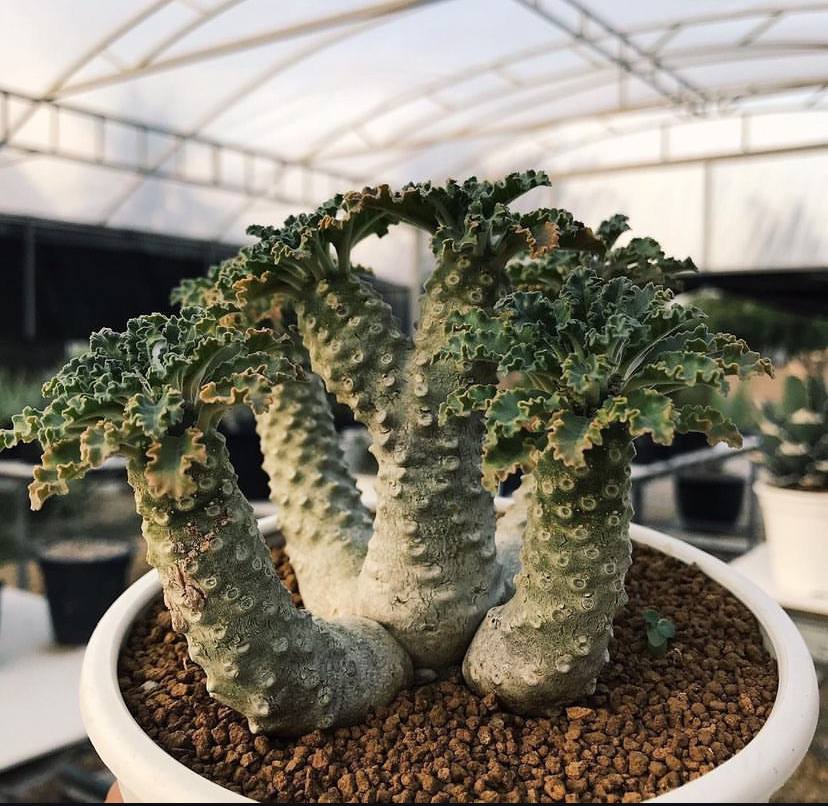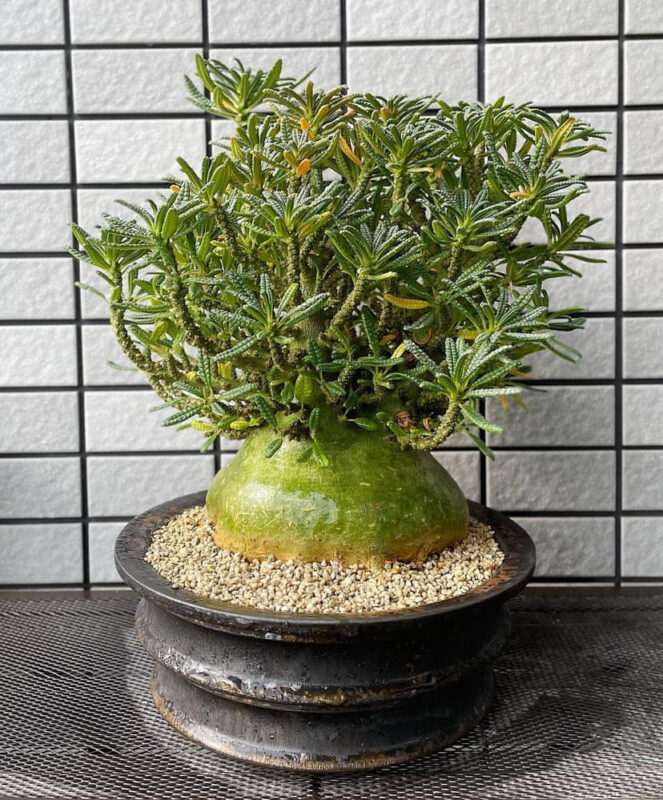Shop Dorstenia lavrani seeds and plants for sale – a rare and unique succulent perfect for collectors and gardeners. Order plants here :http://caudiciformplants.com
Dorstenia lavrani
facebook

Dorstenia lavrani: The Ultimate Guide to This Rare and Beautiful Plant
If you’re searching for an exotic and rare plant to add to your collection, look no further than Dorstenia lavrani. This unique succulent, known for its striking appearance and minimal care requirements, has become a highly sought-after species among collectors, gardeners, and plant enthusiasts worldwide. Whether you are a seasoned gardener or just starting your plant journey, Dorstenia lavrani offers something truly special. Shop plants here caudex shop
In this comprehensive guide, we will explore everything you need to know about Dorstenia lavrani—its origins, care tips, propagation methods, and where to buy Dorstenia lavrani seeds or plants. By the end, you’ll have all the information necessary to grow and nurture this rare and fascinating plant in your own garden or home.
What is Dorstenia lavrani?
Dorstenia lavrani is a rare species of succulent from the genus Dorstenia, which belongs to the family Moraceae. Native to the dry, rocky areas of Somalia, Dorstenia lavrani thrives in arid climates and is well-adapted to low-water conditions. Known for its unique appearance, the plant features a rosette of thick, fleshy leaves that are green, waxy, and often have a slight sheen. These leaves help the plant retain moisture, making it resistant to drought and ideal for xeriscaping or low-maintenance gardening.
In addition to its stunning foliage, Dorstenia lavrani produces small, spherical clusters of flowers that are arranged at the tips of its stems. These flowers, though not large, stand out due to their unusual shape and vibrant color. The plant’s overall appearance and characteristics make it a favorite among rare plant collectors and gardening enthusiasts. shop your plants at: shop
The Origins of Dorstenia lavrani
Dorstenia lavrani is endemic to Somalia, a country known for its arid, rocky landscapes and scarce rainfall. The plant naturally thrives in areas with minimal moisture, which has influenced its hardiness and ability to survive under dry conditions. The species was first identified by botanists in the early 20th century and has since gained recognition as a unique and beautiful addition to the succulent family.
Due to its limited geographic range, Dorstenia lavrani is considered rare, making it even more valuable to collectors and plant enthusiasts. Its natural habitat, characterized by rocky outcrops and dry, well-drained soil, provides the perfect environment for this plant to thrive. Replicating these conditions in a home garden can be challenging, but it’s also part of the allure for those who appreciate the challenge of growing rare plants.
Why is Dorstenia lavrani So Rare and Valuable?
There are several reasons why Dorstenia lavrani is so highly coveted in the plant world. Its rarity is primarily due to its restricted native range, found only in specific arid regions of Somalia. The plant’s slow growth and difficulty in propagation also contribute to its scarcity in the market. Additionally, its distinct appearance, combined with its resistance to drought, makes it a perfect choice for collectors who want a unique, low-maintenance plant that still stands out in any collection.
As a result of its rarity, Dorstenia lavrani can be quite expensive to purchase, especially from reputable nurseries that specialize in rare plants. The challenge of obtaining healthy specimens further increases the plant’s appeal. Whether you’re a seasoned plant enthusiast or a newcomer to the world of rare succulents, adding Dorstenia lavrani to your collection is sure to be a rewarding experience.
Growing lavrani: Care and Maintenance Tips
While Dorstenia lavrani is relatively easy to care for, it requires some specific conditions to thrive. Understanding its needs and replicating its native environment as closely as possible will ensure that your plant grows healthy and strong. Below are some essential care tips to keep in mind when growing Dorstenia lavrani:
1. Light Requirements

Dorstenia lavrani
Dorstenia lavrani requires bright, indirect light to thrive. While it can tolerate some direct sunlight, prolonged exposure to harsh rays can scorch the plant’s delicate leaves. Ideally, place your lavrani in a spot that receives several hours of indirect sunlight each day. If you are growing it indoors, a sunny windowsill or a bright room will work well.
During the summer months, you may need to adjust the plant’s location to prevent it from getting too much direct sunlight, as this can cause the leaves to become discolored or damaged.
2. Soil and Drainage
As a succulent, lavrani requires well-draining soil to prevent root rot, a common issue among plants that retain too much moisture. Use a cactus or succulent-specific soil mix that promotes good drainage. You can also amend your soil with sand or perlite to further improve drainage.
When planting lavrani in pots, make sure the container has drainage holes. Without proper drainage, excess water will accumulate at the bottom, leading to root rot and other health problems. A well-draining mix is essential to simulate the plant’s native rocky environment and ensure healthy growth.
3. Watering Needs
One of the most important aspects of caring for lavrani is ensuring you don’t overwater it. As a drought-tolerant plant, D lavrani thrives on minimal watering. Water the plant only when the top layer of soil feels dry to the touch. In the winter months, the plant enters a dormant phase, and watering should be reduced even further.
Be sure to check the soil’s moisture level before watering, as overwatering can lead to root rot. In contrast, underwatering can cause the plant to become stressed and fail to thrive. Striking the right balance is key to keeping your lavrani healthy and happy.
4. Temperature and Humidity
Dorstenia lavrani thrives in temperatures between 20°C to 30°C (68°F to 86°F). It is not frost-tolerant, so if you live in a region that experiences cold winters, it’s best to grow D lavrani indoors or in a greenhouse. This plant prefers dry conditions with low humidity, making it an ideal choice for indoor spaces with controlled environments.
Avoid placing D lavrani in areas where humidity is high, as this can encourage fungal growth and other health issues. A dry, well-ventilated environment is ideal for the plant’s growth.
How to Propagate Dorstenia lavrani
Propagating lavrani can be challenging, but it is possible with the right techniques. The most common method of propagation is through stem cuttings or offsets. Here are some steps to help you successfully propagate lavrani:
- Select a Healthy Cutting: Choose a healthy, mature stem or offshoot from the main plant. The cutting should be free from damage or disease.
- Allow the Cutting to Callus: After making the cut, let the stem dry out for a few days to form a protective callus. This reduces the risk of rot when planting.
- Plant in Well-Draining Soil: Once the cutting has dried and the callus has formed, plant it in a small pot with well-draining soil. Water sparingly at first, and ensure the soil remains dry for the most part.
- Provide Proper Conditions: Place the cutting in a warm, bright spot with indirect sunlight and allow it to root. This process can take several weeks to months, so be patient and avoid disturbing the cutting during the rooting process.
Where to Buy D lavrani: Find Quality Seeds and Plants
Finding lavrani for sale can be a challenge due to its rarity, but it is possible with some effort. The best places to look for this unique plant are specialty nurseries, online plant retailers, and rare plant marketplaces. Make sure to buy from reputable sellers who provide clear information about the plant’s care and origin.
Before purchasing lavrani, be sure to check the quality of the seeds or plants being sold. High-quality specimens should have healthy roots, vibrant green leaves, and be free from pests or diseases. If you’re buying seeds, look for sellers with a good reputation to ensure the seeds will germinate and grow into healthy plants.
Common Problems with lavrani
Like all plants, lavrani can face a few common issues. However, with the right care, many of these problems can be avoided. Here are some common issues to watch out for:
- Yellowing Leaves: Yellowing leaves can be a sign of overwatering or insufficient drainage. If you notice the leaves turning yellow, reduce the frequency of watering and check the drainage in your pot.
- Root Rot: This is one of the most common problems with succulents and can be caused by overwatering or poor drainage. If your plant shows signs of root rot, remove it from the pot and inspect the roots. Trim off any affected areas and repot the plant in fresh, well-draining soil.























